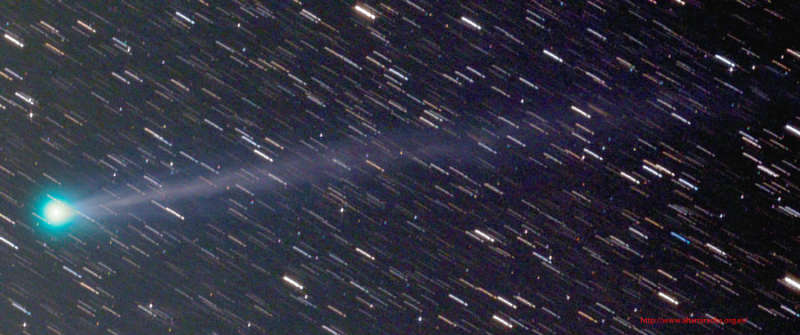Credit & Copyright: Jose Francisco Hernandez
(Altamira Observartory)
Explanation:
A new comet is brightening and is now expected to become visible to the unaided eye
later this month.
C/2009 R1 (McNaught) is already showing an
impressive tail and is currently visible through
binoculars.
The above image, taken yesterday from the
Altamira Observatory in the
Canary Islands
and spanning about five degrees, shows an impressive
green coma and a
long ion tail in front of distant star trails.
Although
predicting the brightness of comets is notoriously difficult,
current estimates place
Comet McNaught as
becoming visible to unaided northern hemisphere
observers in late June, before sunrise, and in early July, after sunset.
Discovered by
Robert McNaught last year, the sun-orbiting iceberg will pass the Earth next
week and will continue to melt and shed debris as it
closes in on the Sun until early
July.
After reaching about half of the
Earth-Sun distance
from the Sun, the comet should fade rapidly as it then heads out of the
inner
Solar System.
1999 2000 2001 2002 2003 2004 2005 2006 2007 2008 2009 2010 2011 2012 2013 2014 2015 2016 2017 2018 2019 2020 2021 2022 2023 2024 2025 |
Yanvar' Fevral' Mart Aprel' Mai Iyun' Iyul' Avgust Sentyabr' Oktyabr' Noyabr' Dekabr' |
NASA Web Site Statements, Warnings, and Disclaimers
NASA Official: Jay Norris. Specific rights apply.
A service of: LHEA at NASA / GSFC
& Michigan Tech. U.
|
Publikacii s klyuchevymi slovami:
Comet McNaught - Kometa MakNota - komety - kometnye hvosty - koma - yadro komety
Publikacii so slovami: Comet McNaught - Kometa MakNota - komety - kometnye hvosty - koma - yadro komety | |
Sm. takzhe:
Vse publikacii na tu zhe temu >> | |
